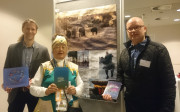
Culture—Not Genetics—Was More Salient for Anglo-Saxons
An Anglo-Saxon burial mound rises in Taplow Court, England. Shutterstock This article was originally published at The Conversation and has been republished under Creative Commons. Scholar…

An Anglo-Saxon burial mound rises in Taplow Court, England. Shutterstock This article was originally published at The Conversation and has been republished under Creative Commons. Scholar…

This article was originally published at The Conversation and has been republished under Creative Commons. An international group of archaeologists has discovered a missing piece in the story…
Direct-to-consumer (DTC) genetic tests offer tantalizing yet speculative promises to connect us with our distant past and live a healthier life. Consequently, by February 2019, an estimated 26…
Rebecca Wragg Sykes is an archaeologist and author of the critically acclaimed bestseller Kindred: Neanderthal Life, Love, Death and Art. An honorary fellow at the University of Liverpool,…
Beliefs about which bodies can and cannot develop certain diseases risk rebiologizing race in genomic research and care. Amyotrophic lateral sclerosis (ALS) is a neurodegenerative disease that typical…
How the conceptual heritage of the new and old world pervades today’s racial economy of genetics. On a former occasion I wrote to you at some length…
Around 50,000 years ago, Neanderthals contributed their DNA to modern humans. But the genes also flowed the other way, hundreds of thousands of years before. In 1856, in…
Selective breeding for milk and muscle has corroded cattle health and genetic diversity. Heritage breed farmers are pushing back. That old cow out there, she’s 18, and she’s…
Back in 1990, researchers embarked on an epic project to map out all of human DNA: the Human Genome Project. Their first draft of the human genome was…

Volunteers and students from the United States and the Bahamas helped excavate the dunes where the Lucayan ancestral remains were found. William F. Keegan Locals in the Bahamas…

The China National GeneBank in Shenzhen opened in 2016 with the goal of storing and researching millions of genetic samples from humans, animals, plants, and microbes. Eben Kirksey…
The collection of genetic biodata for the reunification of families must safeguard individuals’ agency, provide meaningful informed consent, and protect privacy. DNA testing has been used for nearly…

[no-caption] Angus Krieg SAPIENS host Chip Colwell speaks with evolutionary geneticist Hugo Zeberg about his surprising discovery of a connection between Neanderthal DNA and a greater ris…

In the U.K., people of black, Asian, and minority ethnic backgrounds have been disproportionately hard hit by COVID-19. Tim Dennell/Flickr Around the world, there are reports that COVID-1…

[no-caption] KTS Design/Science Photo Library/Getty Images Please note that this article includes an image of human remains. A friend of mine with Central American, Southern European, and…

Scans compare a Neanderthal fossil (at left) to a modern human skull (right). Philipp Gunz/Max-Planck-Gesellschaft Around 200,000 years ago, in what is now northern Israel, a small band…

Nearly a century ago, the focus of human origins research shifted from Europe to Africa—such as to the Oldupai (Olduvai) Gorge in Tanzania, one of the cradles of…
In a cave tucked into the limestone hills of the Asturias region of Spain, there lie the remains of a group of 13 Neanderthals that date to between…

Three researchers stand in Denisova Cave in Russia, home to the newly classified Denisovan skull fragments. IAET SB RAS/Sergei Zelensky/Max Planck Institute for Evolutionary Anthropology …
Composition endures, in fact thrives, at universities that are heavily invested in science, technology, engineering, and mathematics. But, this also means that composition instructors who are primaril…

The Arctic Ark team has presented their work of the last four years in human-animal relations in the Arctic at the Finnish Academy’s final Arktiko Seminar. Studying people’s…

This scanning electron micrograph (SEM) shows healthy spermatozoa emerging from a cavity within the testis. Innerspace Imaging/Getty Images This article was originally published at Aeon. …

[no-caption] Andrew Brookes/Getty Images I have never understood why anybody would think humans are by nature violent, warlike creatures. True, we have all surely had arguments turn sour…
In 1927, the Polish-Jewish physical anthropologist Henryk Szpidbaum published an account of his recent expedition to Mandate Palestine on behalf of the Polish Society for the Exploration of…